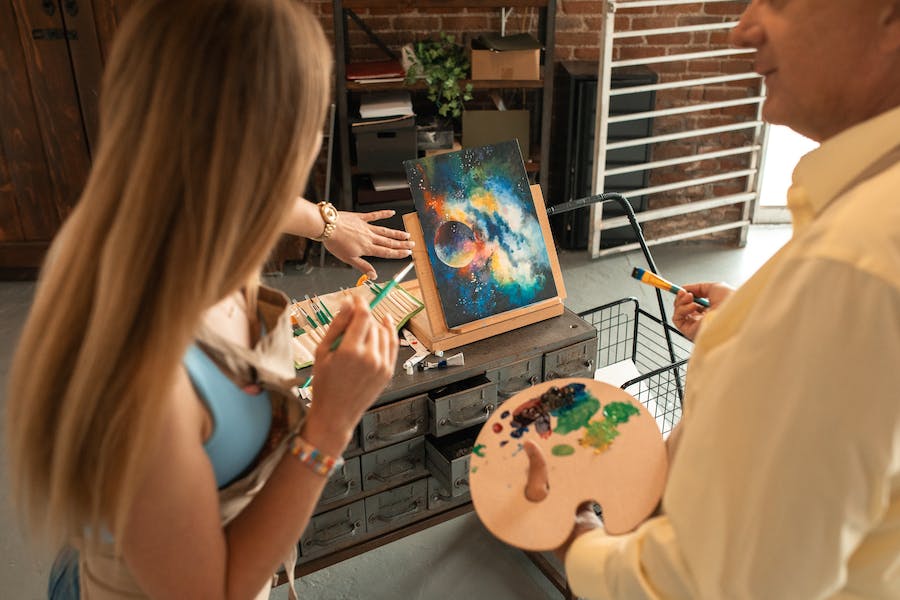The world of modern art is a rich tapestry woven from the threads of innovation, rebellion, and profound introspection. This artistic era, straddling the late 19th and mid-20th centuries, heralded a period of unprecedented creativity. It gave birth to masterpieces that continue to resonate with audiences today. This exploration delves into iconic paintings, legendary artists, and their present locations while acknowledging the role of modern painting reproductions in democratizing these artworks for contemporary appreciation.
The Vanguard of Modern Art
At the forefront of this revolution were artists who dared to defy convention and express deeper truths.
Vincent van Gogh, with his emotionally charged brushstrokes and vibrant colors, created some of the most moving works of the era. His iconic “Starry Night,” housed in New York’s Museum of Modern Art (MoMA), is a testament to his genius.
Pablo Picasso, a titan of modern art, broke the mold with Cubism. His “Guernica,” a powerful anti-war statement, resides in Madrid’s Reina Sofia Museum, captivating viewers with its emotional depth and innovative composition.
Claude Monet, the pioneer of Impressionism, transformed our perception of light and color. His “Water Lilies” series, predominantly located in Paris’s Musée de l’Orangerie, exemplifies his mastery of capturing the ephemeral nature of light.
Diverse Movements of Modern Painting
The era of modern art is characterized by a diversity of styles, each distinct yet interconnected.
Fauvism, with artists like Henri Matisse, celebrated bold colors and wild brushwork, as seen in Matisse’s “The Dance,” a highlight of MoMA’s collection.
German Expressionism offered a visceral, emotional response to the modern world. Ernst Ludwig Kirchner’s “Street, Berlin” displays the movement’s raw power and is a prized piece in MoMA.
Abstract Expressionism, spearheaded by artists like Jackson Pollock and Mark Rothko, focused on spontaneous, abstract forms. Pollock’s “Number 1A, 1948,” located in MoMA, and Rothko’s color field paintings, displayed in various locations, exemplify this movement’s revolutionary approach.
Museums: The Sanctuaries of Modern Art
Prestigious modern art museums worldwide serve as the custodians of these revolutionary works. The Museum of Modern Art in New York, the Tate Modern in London, the Centre Pompidou in Paris, and others play a critical role in preserving and showcasing these artworks. They provide context and narrative, allowing viewers to journey through the evolution of modern art.
The Impact and Legacy of Modern Paintings
The influence of modern art extends far into contemporary practices. Today’s artists draw inspiration from the principles established during this period, from the bold experimentation with color and form to the exploration of existential themes.
The Role of Modern Painting Reproductions
In an age where accessibility to art is increasingly valued, modern painting reproductions have gained significant importance. These high-quality reproductions allow a wider audience to engage with and appreciate these masterpieces, fostering a deeper understanding and love for modern art. They serve as a bridge, connecting the historical significance of these works with contemporary aesthetics and sensibilities.
The Global Influence of Modern Art
Modern art was not confined to Europe and America. It inspired movements worldwide, from Latin America’s magical realism to Asia’s blend of traditional and modern techniques. Artists like Frida Kahlo and Amrita Sher-Gil, although not strictly part of the modernist movement, were influenced by its principles and contributed uniquely to their cultural contexts.
Modern Art in the Digital Age
The advent of digital technology has further transformed the way we interact with modern art. Digital galleries, virtual museum tours, and online exhibitions have made these artworks more accessible than ever. This digitalization has also facilitated the production and distribution of modern painting reproductions, allowing art enthusiasts to experience these masterpieces in new and innovative ways.
Conclusion
Modern paintings, with their rich history, diverse styles, and profound impact, continue to fascinate and inspire. As we navigate the complexities of the contemporary world, the lessons and beauty of these artworks remain more relevant than ever. Through museum exhibitions and modern painting reproductions, these masterpieces continue to engage, challenge, and enrich our lives.

